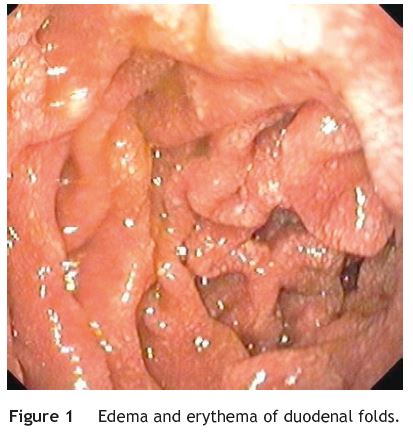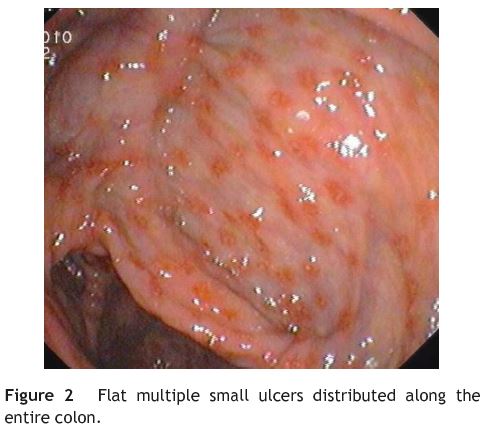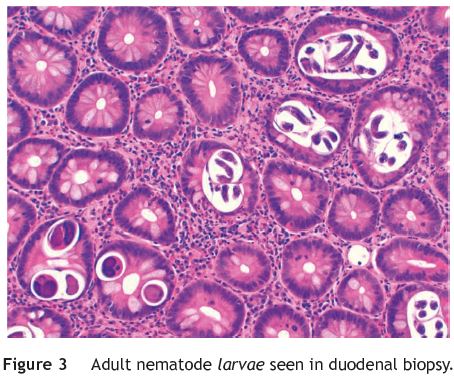Serviços Personalizados
Journal
Artigo
Indicadores
-
 Citado por SciELO
Citado por SciELO -
 Acessos
Acessos
Links relacionados
-
 Similares em
SciELO
Similares em
SciELO
Compartilhar
Jornal Português de Gastrenterologia
versão impressa ISSN 0872-8178
J Port Gastrenterol. vol.20 no.1 Lisboa jan. 2013
https://doi.org/10.1016/j.jpg.2011.10.001
Strongyloides stercoralis and HTLV-1 infection in a patient with adult T-cell leukemia/lymphoma
Infecção por Strongyloides stercoralis e HTLV-1 em doente com Leucemia/Linfoma de células T do adulto
Miriam Magalhãesa,∗, Marta Gôjaa, Amália Pereirab
a Interno de formação específica de Medicina Interna, Serviço de Medicina 1, Hospital de Santo André E.P.E. Leiria, Portugal
b Assistente graduado de Medicina Interna, Serviço de Medicina 1, Hospital de Santo André E.P.E. Leiria, Portugal
*Corresponding author.
A 41-year-old male patient from Guinea-Bissau was admitted in our hospital with anorexia, abdominal discomfort and weight loss (15% of total weight) in the previous month. He was a medical doctor living in Portugal for the last twenty years and had not been to Africa since the previous ten years. He then developed massive watery diarrhea and persistent vomiting. The physical examination revealed no abnormalities. Blood analysis showed leukocytosis without eosinophilia or elevation of C-reactive protein. Upper gastrointestinal endoscopy identified diffuse edema and erythema of duodenal folds (Fig. 1). The colonoscopy showed moderately diffuse colitis with profuse multiple small ulcers surrounded by inflammatory halo and scattered along the entire colon (Fig. 2). Adult Strongyloides stercoralis larvae were seen with the microscope from samples obtained from both upper and lower gastrointestinal tract (Fig. 3). Considering these results, we suspected of an immunocompromising disease. Further study revealed a blood immunophenotyping with abnormal T cell population with increased CD3+ and CD4+ consistent with an adult Tcell leukemia/lymphoma (ATLL). Serology for human T-cell lymphotropic virus type-1 (HTLV-1) was positive. Therapy with albendazole was started as well as chemotherapy with favorable response.



S. stercoralis infection is common in endemic áreas although patients remain asymptomatic in half of the cases.1
Hyperinfection, which is life-threatening, can develop in immunocompromised patients and typically affects the gastrointestinal tract.2 Endoscopic findings may vary considerably but diagnosis can be made in 90% of cases by duodenal or jejunal biopsies.2
Recommended treatment consists of Ivermectin or Albendazole/ Tialbendazole as valid alternatives.1
Co-infection of S. stercoralis with HTLV-1 has been described and there are evidences that HTLV-1 is a cofactor of development of ATLL in adults.3 HTLV-1 is a provirus acquired early in life that disrupts the immune response. This mechanism is not known.4 Unfortunately ATLL carries a poor prognosis despite direct therapy.
References
1. Segarra-Newnham M. Manifestations, diagnosis and treatment of Strongyloides stercoralis infection. The Annals of Pharmacotherapy. 2007;41:1992-2001. [ Links ]
2. Mittal S, Sagi S, Hawari R. Strongyloidiasis: endoscopic diagnosis. Clinical Gastroenterology and Hepatology. 2009;7:e8. [ Links ]
3. Grijsen M, Van den Berk G, Hoekstra E, Terpstra W, Veldman S, Jansen J. Intestinal strongyloidiasis in HTLV-1 associated ATLL. Endoscopy. 2009;41:E271-2. [ Links ]
4. Iriemenam N, Sanyaolu A, Oyibo W, Fagbenro-Beyioku A. Strongyloides stercoralis and the immune response. Parasitology International. 2010;59:9-14. [ Links ]
Conflicts of interest
The authors have no conflicts of interest to declare.
*Corresponding author.
E-mail address: miriambb78@yahoo.com (M. Magalhães).
Received 28 May 2011; accepted 9 October 2011













